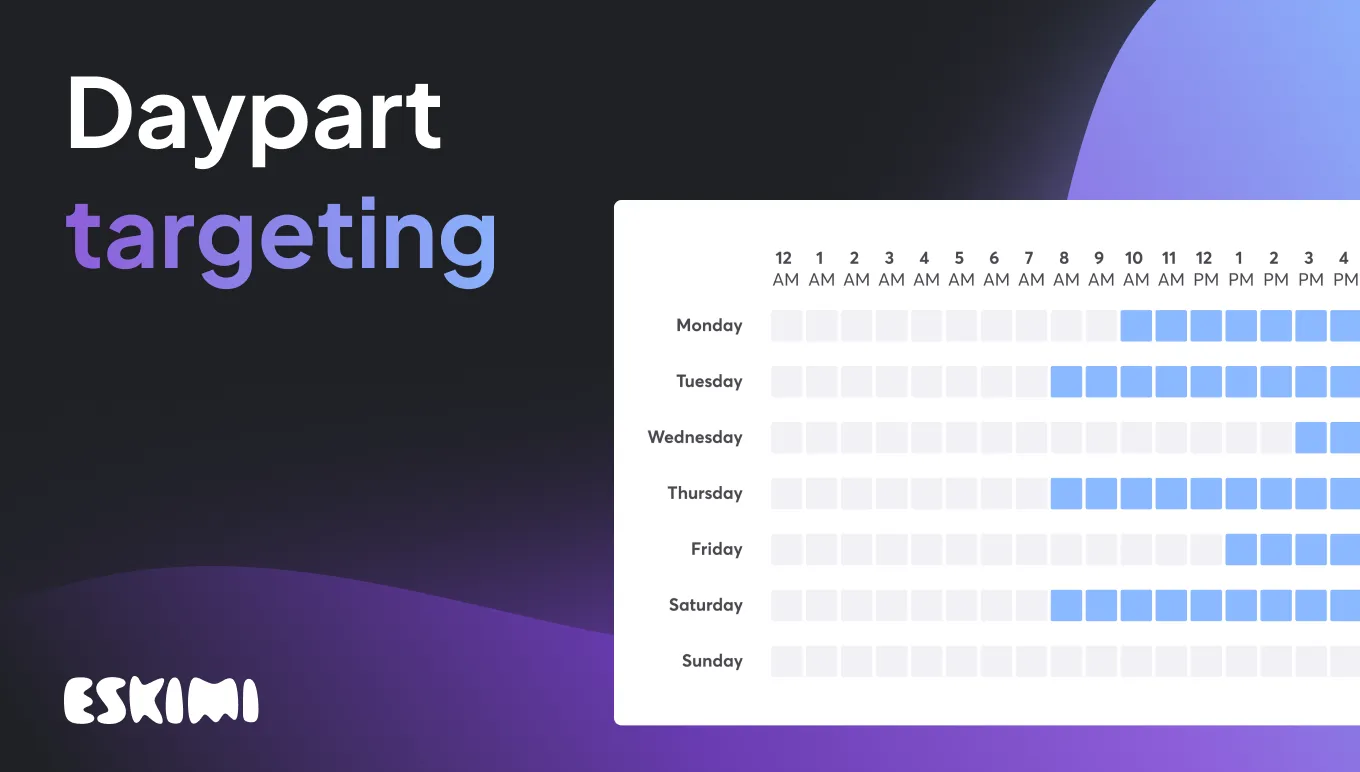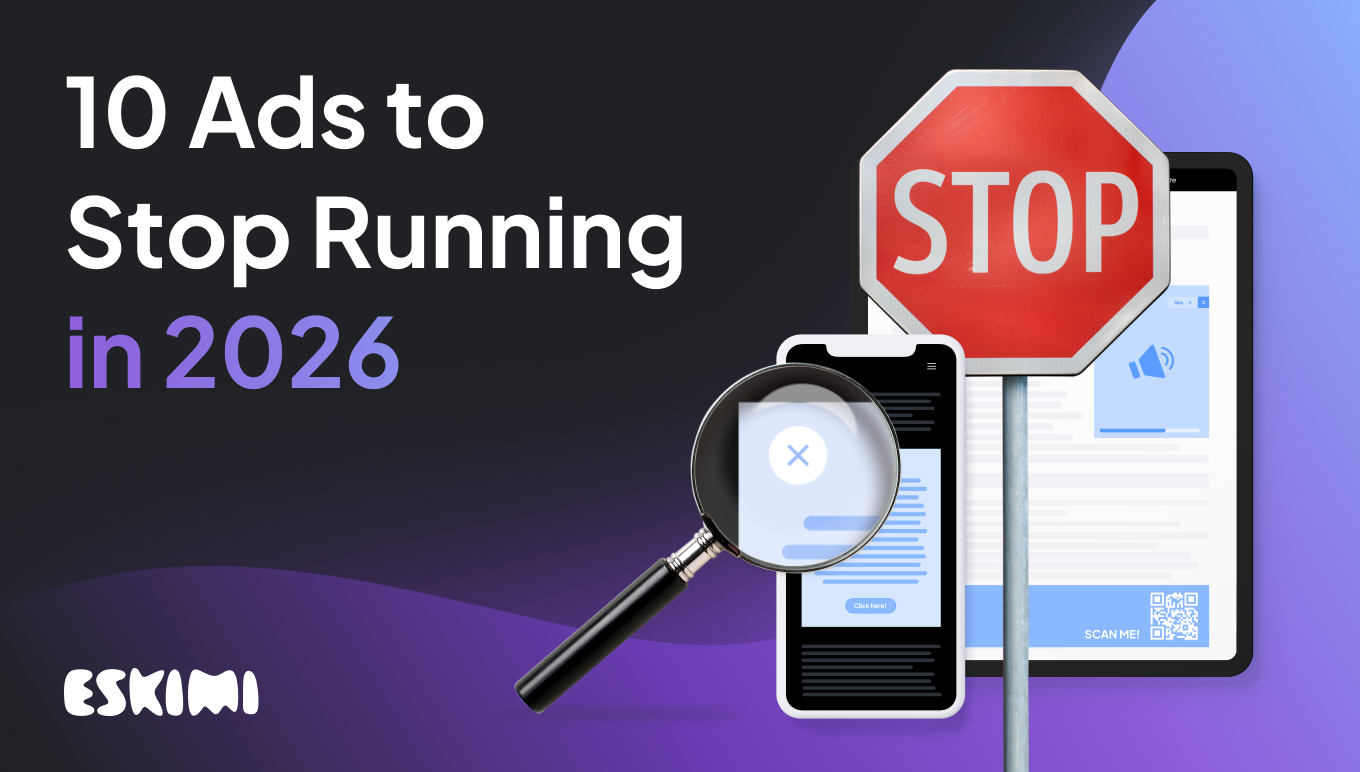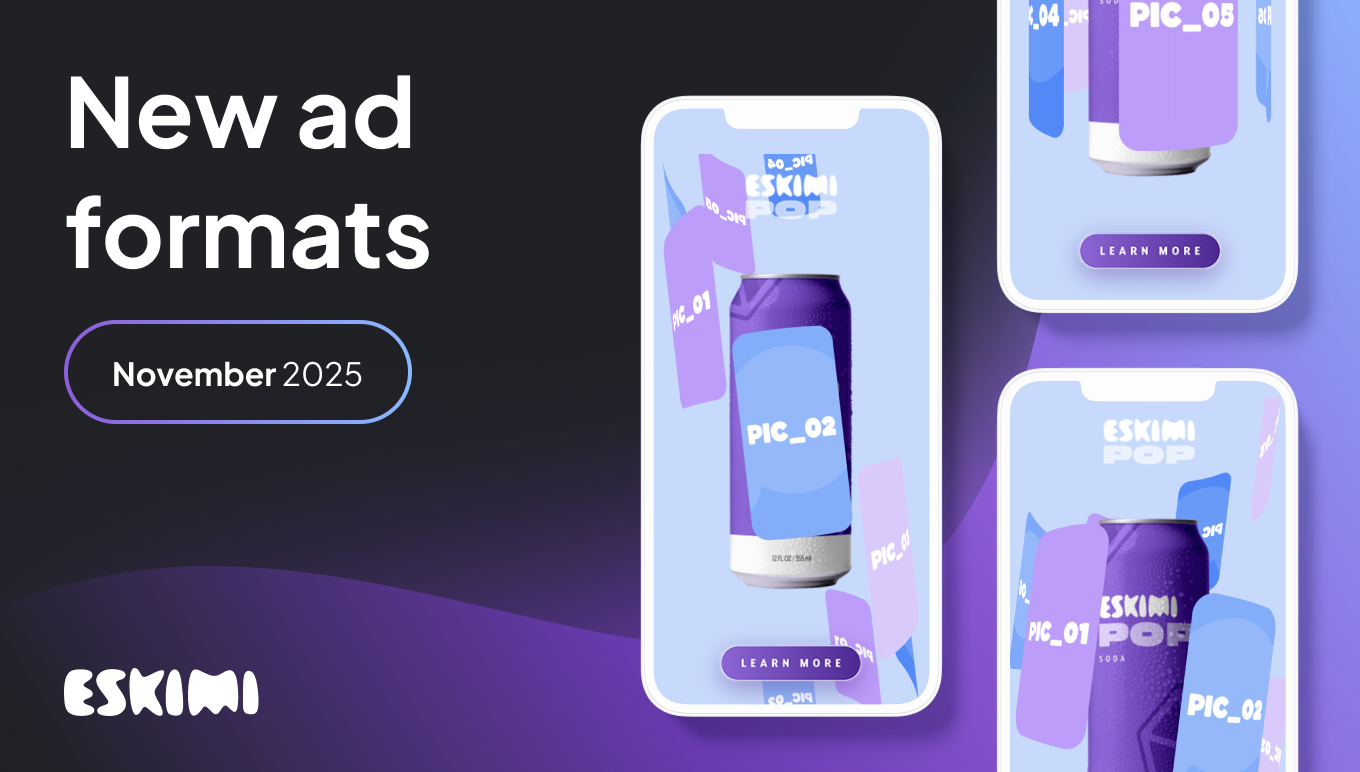Dayparting: The complete guide to maximize ad ROI

Running efficient advertising campaigns is easier said than done.
Knowing your target audience is key to any marketing strategy, including not only knowing who they are but also when they’re most active online.
For instance, you’re likely aware of general rules about the best times to post on social media. Just like that, particular ad campaigns can also perform better when launched with a focus on certain times of the day.
This is what we call daypart targeting. In this post, you’ll learn:
- What is daypart targeting
- Why use it and what are the disadvantages of it
- How to choose the best timing for your ads
- Draw inspiration from examples and collect ideas for your next campaign
What is daypart targeting in marketing?
In digital marketing, advertisers use daypart targeting tactic to serve their ads during specific times of the day or certain days of the week.
This helps advertisers target their audiences betterbetter, assuming that the users they want to reach will be most active online during chosen times, thus more likely to see the ad.

In the past, the term dayparting was mainly associated with television and radio since their schedules were (and still are) divided into different time segments, like morning, daytime, prime time, or late night.
Broadcasters use these schedules to better determine the cost of ads, depending on how many of their viewers/listeners are in front of the TV or listening to the radio during those times.
Put simply, more eyes equals a higher price, and low viewership tends to be less expensive.
Similarly, dayparting is one of the targeting types available for online advertisers that can improve campaign results when done right. By limiting purchasing of ad placements during specific days and times of the day, it can help run ad campaigns more efficiently.
Why use dayparting?
If given the opportunity, brands wouldn’t probably mind staying in front of potential consumers 24/7.
The thing is, buying every ad placement available doesn’t sound realistic, not to mention how wasteful this would be for your ad budget, especially during low-conversion hours.
It all comes down to showing the ads to the right people at times when they’re most likely to convert—reaching the right audience at the most effective times by identifying and leveraging peak times for ad delivery. Optimizing your ad schedule through dayparting can deliver significant benefits, like improved ROI and overall campaign effectiveness. And this brings us to the following daypart targeting benefits.
Better ad campaign optimization and effectiveness
Brands that sell products for clearly defined audiences are usually familiar with times when their potential customers are more likely to go online. Daypart targeting enables businesses to benefit from it and run ads when they can provide the most value.
For example, if you sell baby and children’s products, it’s almost certain that the biggest part of your target audience is mothers. Likely, they spend most time browsing the internet between activities, like in the morning after the kids are off to school or during lunchtime when the little ones are napping.
Therefore, these might be the only times during the day when you can catch their attention with your ads.
Daypart targeting allows you to optimize your campaigns and allocate your budget for showing ads at these specific times, which brings us to two other possible dayparting benefits – higher visibility and better results.
Increased visibility and results
Finding the best time to serve your ads can also result in better brand visibility and more conversions. Scheduling ads during less competitive periods can lead to more impressions, increasing your campaign's reach.
Using dayparting, you get to advertise to people who are already highly engaged in online content and have some free time on their hands. By experimenting with different time slots, such as daytime, early fringe, and primetime, you can identify the best periods for maximizing reach and conversions. You can use it as an opportunity and show them the best of what you’ve got.
Even if they don’t convert at that exact moment (and there can be many reasons for that, including longer checkout or something simple like not being able to decide on the color of the product), you still get the chance to increase your brand awareness by reaching people you’d like to turn into customers.
Daypart targeting drawbacks
However, as good and simple as daypart targeting sounds, it’s not a guaranteed advertising method. You have to consider many other aspects of your business – like business type, niche, the country you advertise in, even the browsing habits of your audience, etc. – and ad campaign before getting your hands on it.
It means that while getting more eyes on your products/services might sound great, those might not always be the (only) optimal times for you.
Dayparting is not universal
It’s quite easy to set time schedules on TV or radio where it was first done originally, but online content consumption is not monolithic. People use the internet throughout the day, and the times can still fluctuate. Managing campaigns across different time zones can further complicate dayparting, making it challenging to coordinate ad schedules effectively.
Depending on the industry you’re in, how diverse your audience is, and many other things, this targeting option can be more damaging for you rather than beneficial.
For instance, if you run an e-commerce business, your audience is broad, and you sell large-appeal products, limiting your ads to specific times or days of the week can mean isolating (and, consequently, losing) a part of your prospects.
Daypart targeting can increase ad costs
That’s not necessarily the case for everyone, but sometimes dayparting results in higher ad costs.
This usually happens when businesses identify similar peak activity times and the competition for the same ad placements increases. Bidding for popular time slots can drive up ad costs, as advertisers compete to reach audiences during high-engagement periods. Naturally, the fiercer competition, the more you pay for showing your ads.
So before setting specific times for your ads, make sure to carefully evaluate whether or not your business can take advantage of dayparting.
Setting up dayparting: A step-by-step guide
Here’s how to set up dayparting for your advertising campaigns and make the most of your budget:
1. Identify your target audience
Start by pinpointing exactly who you want to reach with your ads. Dive into your customer data to uncover user behavior patterns—look for trends in when your audience is most active online and most likely to engage. Consider demographic factors such as age, location, and interests to build a detailed profile of your ideal customer.
For example, if your goal is to connect with younger audiences, you might find that early morning hours or late night are prime times to schedule your ads, as these audiences tend to be more active during those periods. Use this data-driven approach to ensure your ads are shown at the right times to maximize engagement.
2. Choose the right advertising platform
Once you know your audience, select the advertising platform that best supports your dayparting strategy. Evaluate each platform’s capabilities and choose the one that aligns with your strategy, whether you’re looking to reach users during certain times of the day, specific days of the week, or both. If you're not sure what capabilities you will need, consider going for managed service platforms like Eskimi, where experts will help you set up your advertising campaigns to meet your KPIs.
3. Configure your ad schedule
With your platform chosen, it’s time to set up your ad schedule. Use analytics tools to identify which days of the week and times of the day deliver the best results for your ads. For example, if you run a local business, you might want to schedule your ads to appear during business hours, when customers are most likely to be searching for your products or services. Adjust your schedule based on this data to ensure your campaigns are running at the most effective times.
Daypart targeting indicators: how to find the best times?
Daypart targeting sounds really straightforward, and that is one of the key reasons why some of the most common pitfalls with this strategy are lack of research and short-sightedness.
Businesses tend to misinterpret analyses when they’re segmented into such small buckets as hours of the week (if the analysis is conducted at all). Sometimes, it’s just easier to make assumptions about the target audience and its activities.
So as with any other strategy, you should test daypart targeting and thoroughly analyze the data you already have.
Here are a few ideas on how to do it.
Checking universal data
Although daypart times may vary from industry to industry and brand to brand, you can still look at some market-wide observations to determine when people are most likely to convert.

For example, in 2020, most of the online sales were happening on Wednesday and Thursday, significantly dropping on Saturday, according to SaleCycle. 10-11 AM and 8-9 PM were the most popular hours for shopping online.
Still, you shouldn’t follow these times blindly as – again – those are not universal for everyone and can be impacted by several other factors (in this case, the global pandemic and online shopping boom).
PRO TIP: Instead of fully relying on universal data, be original when choosing the best times for your ads. As great as peak hours sound, the competition during those times is usually the highest. In such cases, original decisions can bring you better results.
Spotting traffic and conversion trends
You can search for higher traffic and conversion patterns based on the business data you already have (e.g., data from your CRM or Google Analytics).
Since you’d be looking at your own numbers, this method could already be much more accurate and easier to rely on.
Analyzing past campaigns
Regardless of what you use to run ads (DSP, social media, etc.), you should be able to access ad campaign reports that can provide you with valuable information for planning your future campaigns.

For example, the best indicators to look for in the campaign report for determining the best times for dayparting can be delivery by weekday, delivery map by the hour, and similar.
You can also check general graphs to identify the days with the highest reach and click-through rates.

Don't rely on just one successful campaign – do a comprehensive analysis to spot some clear and valuable patterns.
5 daypart targeting ideas and examples for inspiration
Let's get to the fun part.
Below you'll find some daypart targeting examples and ideas on using this targeting option to your advantage.
1. Reach people with relevant messages during events
Events that attract thousands of people can be a good focal point for running promotions at specific times. Of course, not all businesses will be able to benefit from FIFA World Cup or World Fencing Championship, but being aware of such events can provide some extra opportunities.
A few examples that you can draw inspiration from:
- Brands operating in the FMCG industry can serve ads before big sports games (basketball, football matches, etc.), e.g., promote new potato chip flavors, soft drinks, other snack food.
- Betting companies can invite prospects to guess the winner or final score.
- Electronic or clothing brands can advertise before big trade shows or festivals, e.g., promoting discounts on fancier outfits, new tech gear, etc., depending on the topic.

2. Exclude irrelevant times
Excluding irrelevant times can be as important as choosing the right ones when using daypart targeting.
Suppose you've been observing the behavior of your target audience and noticed there are specific times during the day when your prospects aren't active or converting. In that case, excluding those times from your advertising schedule might be a good idea.
For example, Addiko Bank in Serbia, which ran a campaign with Eskimi DSP, excluded nighttime targeting from its campaign as it noticed that during that time, the ad performance was the lowest in terms of getting leads.

Excluding nighttime is a common practice among industries as most people are sleeping, and running promotions at this time can be wasteful.
3. Promote during a particular time of the day
Creating time blocks to reach prospects with your ads during particular days or the time of the day can be beneficial when done right. Depending on your business and even the idea, the opportunities here are endless.
For instance:
- Although excluding nighttime usually makes sense, you can still promote to segmented groups of your audience that are likely not sleeping. E.g., serving coffee ads to nurses, the non-slip shoe offers to servers and bartenders, etc.
- Breakfast/brunch shops and cafes can promote their meals in the morning.
- Bars and restaurants can schedule most of their promotions on Thursday, Friday, and Saturday.
You can also use dynamic banners that can be triggered only in particular locations and time of day, e.g., when the temperature is above 30 degrees Celsius.
For this, you might want to observe the weather forecast to be able to schedule your promotions for specific days.
A good example of this is Unilever's summer campaign for Clear. Its marketing communication was supported with dynamic rich media banners, triggered only in specific locations and time of day (when the temperature was above 30 degrees Celsius), allowing Clear to engage with its consumer on a more personal level.

4. Serve ads when your prospects are most active
If you analyze your data and know when your target audience is the most active or likely to act, you can design your ads and choose the best timing based on the information you have.
This can help you focus on a narrower but more relevant audience, also known as the right people.
For example:
- If you sell to students, you might want to focus on late hours and exclude morning hours.
- Mothers are likely to be active during morning hours and around lunchtime.
- Gym goers can be targeted during early mornings or after work hours, etc.
5. Advertise during working hours only
Depending on your business and CTA, sometimes it can make sense to advertise only during working hours.
For example, if you have a physical store and want to attract more customers, showing ads outside working hours can lower your foot traffic. On the other hand, if driving people to your store quickly is one of your goals, you might want to combine daypart targeting with location advertising.
It doesn't mean that customers wouldn't visit you the next day or go to your online store, but if they want to contact you and ask questions, you might want to slow down your ads a bit to avoid disappointment.
Ready to try daypart targeting?
Dayparting in digital advertising can be tricky. When done right, it can help to reach your target audience effectively, but this type of targeting can also come with some significant disadvantages.
There's a lot to consider and research, not to mention running tests and measuring the outcomes of your campaigns to make informed decisions. For the best results, you have to be sure about your findings.
Made up your mind and ready to go? Reach out to the Eskimi team or book a demo for a smooth start.
Level Up Your Advertising with Eskimi
- Reach 96% of Open Web
- 2,500+ Targeting Options
- 100% Managed or Self-Service
- In-House Creative Studio Team
- Display, Video, In-Game & CTV
- #1 Rated DSP on G2




.png)